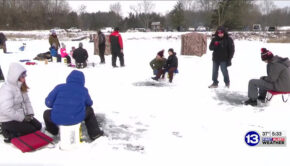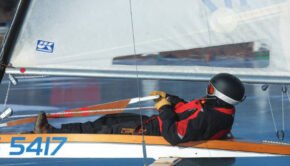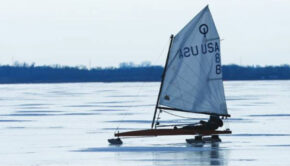Ice Sailing and Ice Harvesting
Published on February 6th, 2019
When the team at Scuttlebutt HQ does local sailing, it is on San Diego Bay where the kelp is a frequent nuisance. On a bad day, it is hard to find water without obstacles, which is sort of what this fleet of iceboaters faced during the early 1900s:
Minneapolitans were pleased and excited by having successful ice companies right in the city. Icehouses went up in the neighborhoods, shortening the distance to deliver ice on hot summer days. The Cedar Lake Ice Company was the largest and most successful of the ice companies, harvesting from Cedar Lake, Bde Maka Ska, and the Mississippi River.
Ice formed quickly in those cold winters. A foot of ice could easily form in four or five days. Even overnight the new ice was thick enough for hockey players to get out onto their “fresh rink.”
Originally, sportsmen had great relationships with the ice companies. But by 1901 those living on the shore of Bde Maka Ska complained that the ice companies had depleted the lake level by 16 inches. That seems unlikely, since some water was also draining into Lake Harriet. The point was made, but even worse, iceboating was ruined for the season.
Six different ice companies had claimed most of the lake for their harvesting operations. The clear expanse of ice wanted for a sail across the lake was blocked. And with as many as 50 iceboats in the Lake Calhoun Ice Yacht Club, there was hardly room to turn around, let alone race.
The shore was privately owned — in some places by the ice companies. The neighbors and iceboaters tried to combine forces with the Park Board and Minikahda Club, but the Minnesota Supreme Court affirmed the companies’ right to harvest ice.
The people took matters into their own hands. They poured kerosene oil on the ice. The Cedar Lake Ice Company retaliated by laughing that those responsible would simply have to pay more for their unspoiled ice in the summer. And when that didn’t stop them, the ice company started spreading ashes on the ice tracks used by the iceboaters.
Eventually, each side agreed to stay to their own part of the ice sheet. But this was resolved only when the ice companies moved to cleaner waters further from the city and stopped harvesting Minneapolis lake ice.
Cold but snowless winters were best for both ice sailing and ice harvesting. No wonder there was conflict.
Source: www.southwestjournal.com









 We’ll keep your information safe.
We’ll keep your information safe.